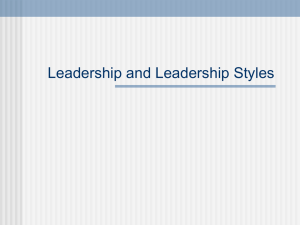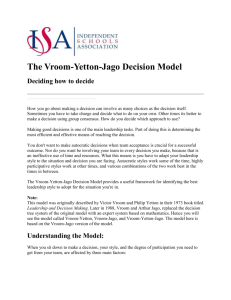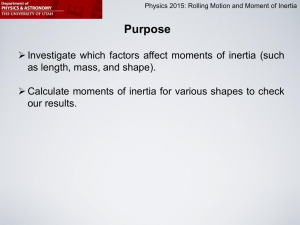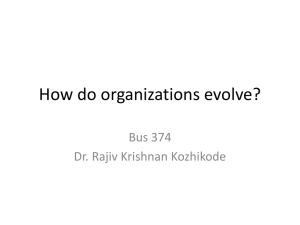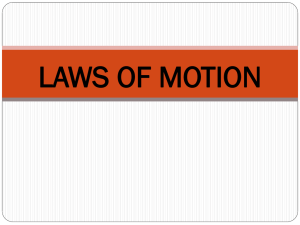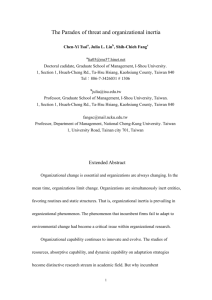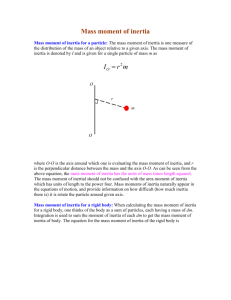3.1 C Change Management exams
advertisement
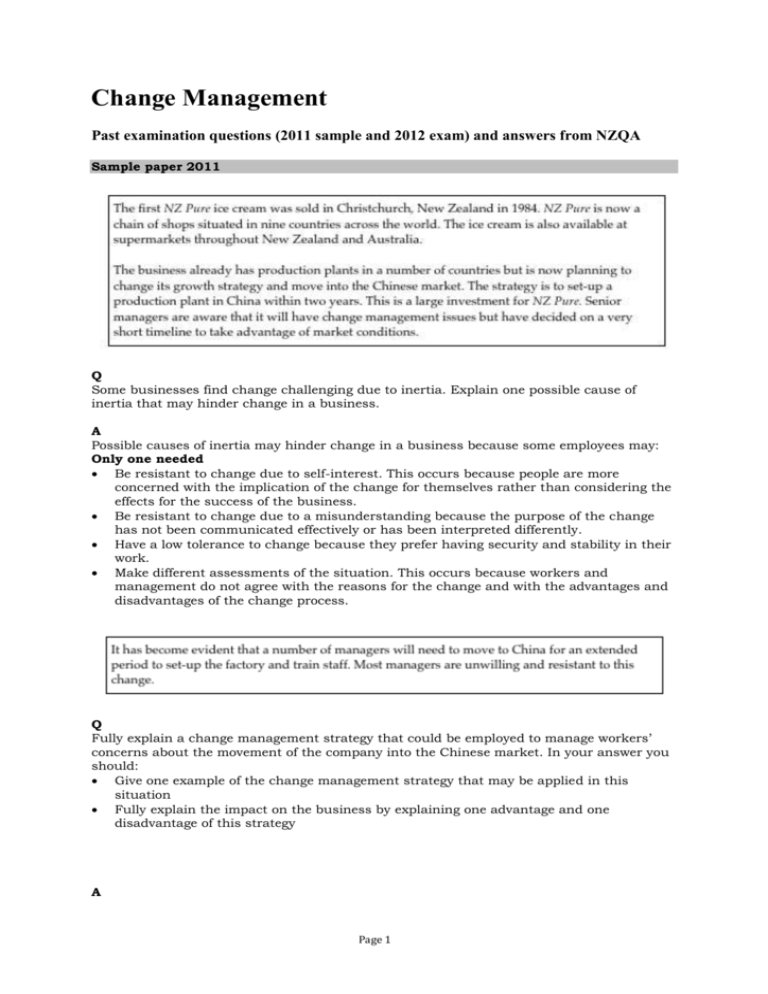
Change Management Past examination questions (2011 sample and 2012 exam) and answers from NZQA Sample paper 2011 Q Some businesses find change challenging due to inertia. Explain one possible cause of inertia that may hinder change in a business. A Possible causes of inertia may hinder change in a business because some employees may: Only one needed Be resistant to change due to self-interest. This occurs because people are more concerned with the implication of the change for themselves rather than considering the effects for the success of the business. Be resistant to change due to a misunderstanding because the purpose of the change has not been communicated effectively or has been interpreted differently. Have a low tolerance to change because they prefer having security and stability in their work. Make different assessments of the situation. This occurs because workers and management do not agree with the reasons for the change and with the advantages and disadvantages of the change process. Q Fully explain a change management strategy that could be employed to manage workers’ concerns about the movement of the company into the Chinese market. In your answer you should: Give one example of the change management strategy that may be applied in this situation Fully explain the impact on the business by explaining one advantage and one disadvantage of this strategy A Page 1 Only one needed Communication ~ Educate people about the changes beforehand. Communication, before the change takes place, helps employees see the logic and reduces rumours. This management strategy Will increase information on the move over to China so workers will be more informed. Does not mean that the company had dealt with the causes of the inertia, they have merely provided greater information. Participation and Involvement ~ When workers are involved in the change programme they are more likely to agree with change rather than resist it. This management strategy Is likely to lower resistance and may increase motivation because people feel more involved May cause change to take a longer time and be more costly, which would reduce profitability Support ~ Management can avoid potential resistance by being supportive of employees during this difficult time. This management strategy Will make employees feel they are supported by the company and they may be more motivated and productive May be expensive in meeting the housing and other needs of managers Negotiation ~ Managers can overcome resistance by offering incentives to employees. This can be done by allow people who are resistant to change alter elements of the movement that they find threatening. This management strategy May be expensive and time consuming, which would increase the costs of change and reduce profitability May mean that managers feel more supported and therefore motivated to move to China Coercion ~ Managers can openly force employees into accepting the change by making it clear that resisting change can lead to employees losing jobs or the firing of, or not promoting, employees. This management strategy Would create change quickly and is cheaper than other change management methods Would only work well if managers do not have alternative employment, which may mean the firm loses good managers and productivity Q Evaluate two leadership styles that could be employed to manage the change in the company’s strategy. In your answer you should Explain how the leadership styles would be employed Fully explain the possible positive and negative impacts these leadership styles may have on NZ Pure’s venture in China Come to a justified conclusion as to which leadership style you feel is more effective A Only one needed Autocratic ~ authoritarian leaders make decisions independently and direct workers that they have to move to China to support the development of the new factory Positive impacts It may work effectively when timelines are short (as they are in this case) because this leadership style does not need a prolonged decision-making process It may work effectively with low-skilled workers because they are being told what to do. Negative impacts Managers may be highly-skilled and feel undervalued, which will reduce motivation May be demotivating as there is little input from others in the team. Democratic ~ these leaders offer guidance and support to the people who will be travelling to China but they also allow these people to have input into the strategy Positive impacts It maximises input from all managers, which leads to a more effective and agreed strategy It may increase motivation because it makes people feel more valued Page 2 Negative impacts It requires an experienced manager to lead the process It may cause the implementation of the change to take longer than an autocratic leadership style Laissez-Faire ~ these leaders offer little or no guidance for group members and leave decision-making up to group members Positive impacts Managers may be more motivated if they are allowed to make their own decisions about travelling to China It may be effective because NZ Pure has competent experienced management Negative impacts It is generally only effective in situations where timelines are longer, which they aren’t in this case It might mean that too few people travel to China because they may not choose to go Conclusion A democratic leadership style would be more effective because this is a large change for NZ Pure and the business would need support and input from all areas of management. OR An autocratic leadership style would be more effective because there is a very short timeline and changes need to happen quickly. Exam 2012 Q Explain why the ability to respond to change is an important characteristic of all modern business. A Businesses are affected by many internal and external factors that cause change. Firms must be able to respond to these changes if they are to continue operating. Page 3 Q Fully explain how demonstrating rangatiratanga would allow the changes required. In your answer you should refer to Relationship development and maintenance Problem-solving A Relationships will have to be built and maintained with workers on the production line, to allow them to feel supported through the changes that will occur (Explain). This will allow them to feel more secure during the changes, and therefore improve morale (Fully explain). Problem-solving is an important element of rangatiratanga, as well as in the change management in the design office, because unexpected events will have to be dealt with (Explain). This will allow a more straightforward change process and improved productivity (Fully explain). Q Evaluate the strategies Sarah and Hayley could employ to overcome the resistance to change. In your answers you should Explain two change management strategies that could be implemented in the design department Fully explain the possible impacts of these strategies on the performance of the department by explaining one positive and one negative outcome of each strategy Provide a justified conclusion as to which would be the more effective strategy A Strategy 1 Top down change management - change will occur when the managers exercise authority and impose sanctions, because they are the leaders and know what is required. A positive outcome – with the topdown/dictated approach, change will occur much faster, because there will be less need to discuss issues with workers (Explain). This will allow the business to return to full production levels more quickly (Fully explain). A negative outcome is that the strategy may miss ideas from workers, which may make the change less successful (Explain). This may reduce performance below what is potentially available (Fully explain). OR A top down/dictated approach by managers would be contrary to aspects of rangatiratanga, e.g. development, relationship-building, conflict resolution, peacemaking, etc. Strategy 2 Involve the designers in planning and organising change, because they should be regarded as intelligent people. A positive outcome of an inclusive approach is that the designers will have input into the changes, and so a wider range of ideas is shared (Explain). This will result in greater Page 4 buy-in by staff, and will maximise the potential benefits of change (Fully explain). A negative outcome is that people against the changes will get a greater opportunity to be negative about change (Explain), and this negativity might spread, decreasing motivation across the workforce (Fully explain). Conclusion An inclusive approach should be chosen. This is because although it may take longer, the workers will feel valued because they are involved. This may increase motivation and therefore productivity. This also follows the principles of manaakitanga (Justify). Page 5


